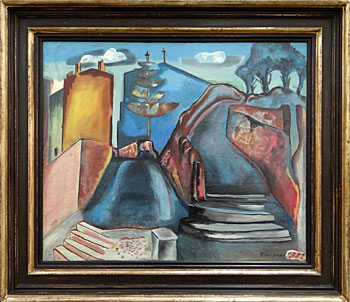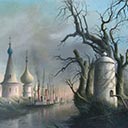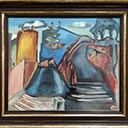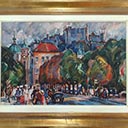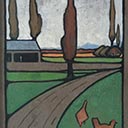Monastery Steps 1934-35
58.4 x 70.2 cm
est. $250,000 - 350,000
PROVENANCE Ex estate of Mr Ian L. Philips esq., London, UK Private Collection, Auckland
The bay of Ibiza is dominated by the ancient fort of Dalt Vila, its huge stone ramparts zigzagging up the hill loom over Sa Penya, the name given to the oldest part of the town. When Frances Hodgkins came to Ibiza at the very end of 1932 the town had already begun to sprawl across the bay. She stayed at the newly opened Hotel Balear, and although she initially complained about the cold and choice of food, gradually the town and its inhabitants captured her imagination. While on the island she produced a series of watercolours which are lyrical both in their colouring and delineation of the bold architectural forms visible at every turn. No doubt she also did drawings, although many of these are now lost.
It was only after she returned to England in the middle of 1933 that she started working on a number of oil paintings that coalesced what she had observed. First exhibited at the Leicester Galleries in London in 1935, Monastery Steps produces an immediate reaction when shown to Ibizans. They immediately point to the blue building and say, 'That's the monastery' (not the cathedral). It nestles behind a line of houses which drop away precipitously on the left, and is approached by a broad set of stone steps. But the right hand part of the painting is drawn from a vantage point on the opposite side of Dalt Vila, and shows the winding path (now a sealed road) that leads up from Puig des Molins (Hill of the Windmills) whose bulky forms dominate the skyline to the east.
The work accentuates blocks of colour, carefully considered curves and individual architectural forms, tied together by a series of strong verticals. At first the broad paths and block-like buildings catch our attention, followed by the strong verticals that bind the picture together. A pine tree soars up in front of the monastery wall, its pointed tip creating a secondary cross beside the crucifix on the highest point of the monastery. Hodgkins has thought very carefully about how she wants colour to work in this painting, for in reality it is the monastery that is ochre-coloured, while the left hand building is painted the blinding white used for most traditional buildings. The rich emerald green is a colour entirely of her own imagination. Therefore, while Monastery Steps refers to places that Hodgkins has observed first hand, the final painting is a terrific demonstration of how an artist transforms the literal into a creative refinement that is entirely her own.
MARY KISLER

